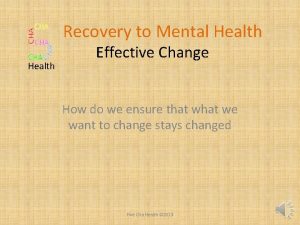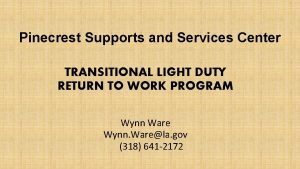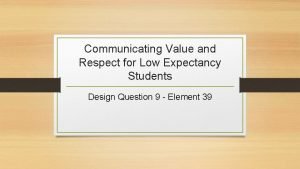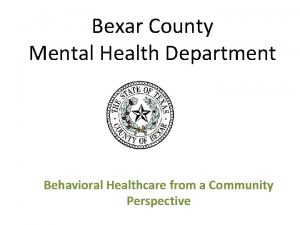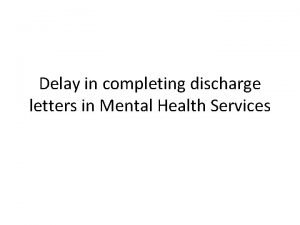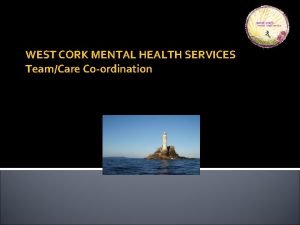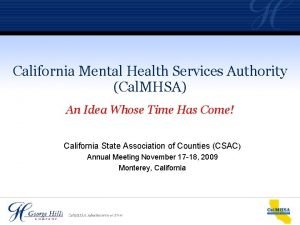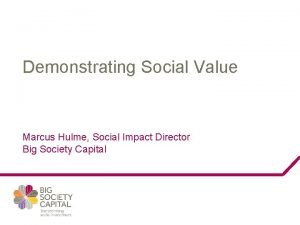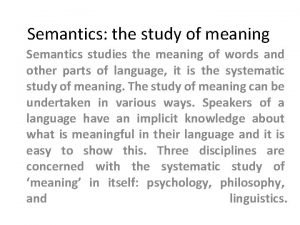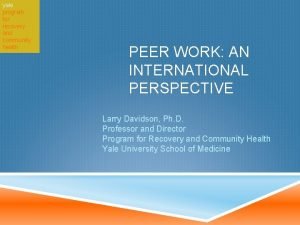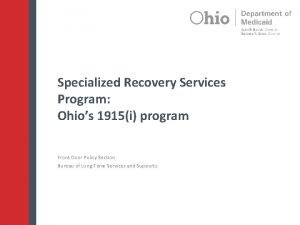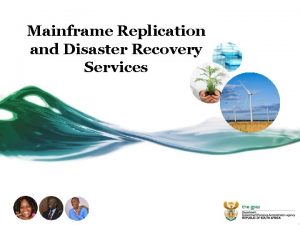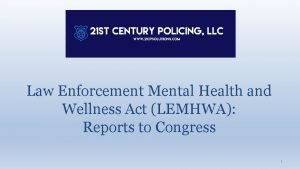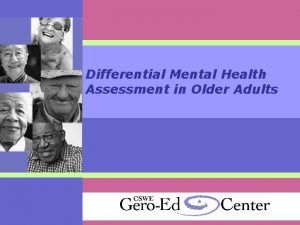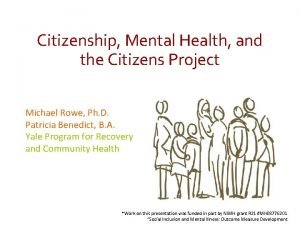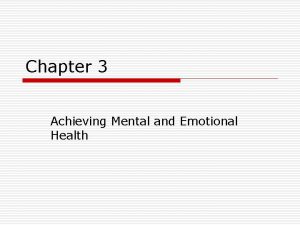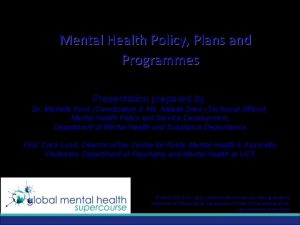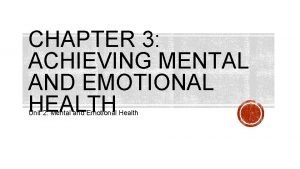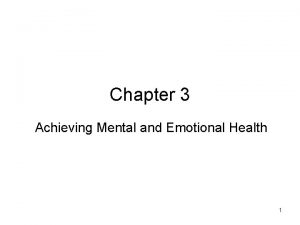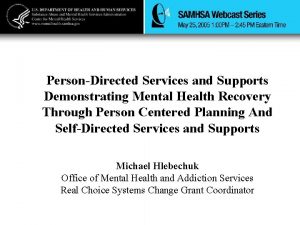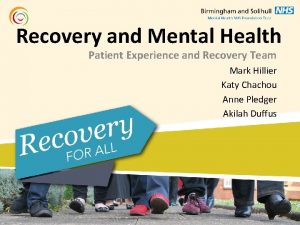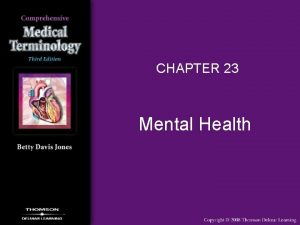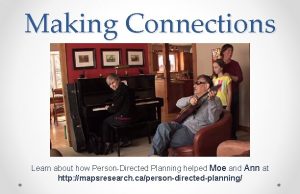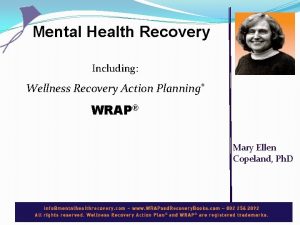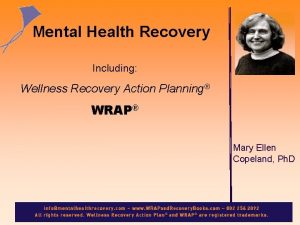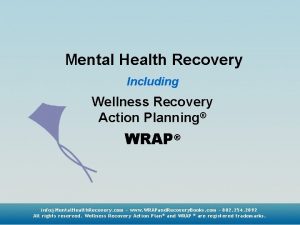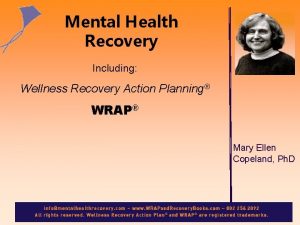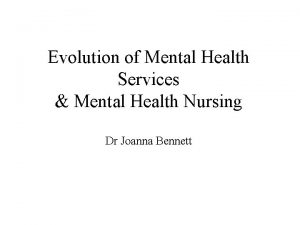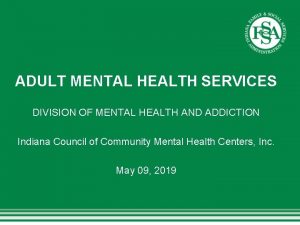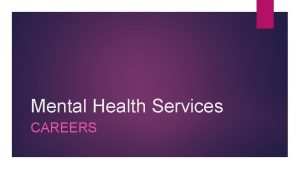PersonDirected Services and Supports Demonstrating Mental Health Recovery































- Slides: 31

Person-Directed Services and Supports Demonstrating Mental Health Recovery Through Person Centered Planning And Self-Directed Services and Supports Michael Hlebechuk Office of Mental Health and Addiction Services Real Choice Systems Change Grant Coordinator

Self-Determination • Self-determination hinges on the ability to make decisions that direct one’s own life. It is crucial to self-determination for people to believe they have the right to direct their own lives. All to many people who receive mental health services do not believe they have this right. • Self-determination is essential to recovery and increases with recovery.

The Traditional Mental Health System • Assumes that clients are not able to make choices that are in their own best interest much of the time. • Believes it is often necessary to make decisions for clients.

The Traditional Mental Health System (continued) • Stresses client safety far more than client choice. • This results in the client growing dependent on the system to make important life decisions. (Decreased client choice means increased client dependence. ) • The next slide illustrates this dependency in an ironic manner.


A Transformed System that Promotes Recovery • Believes that people can and do recover from mental illness. • Helps facilitate recovery by providing self-directed services and supports. • Treatment in this system is centered around the goals of the person – what is important to the person.

A Transformed System that Promotes Recovery (continued) • Safety issues are addressed in a collaborative relationship between the individual and the provider of services and supports. • Individuals have the authority to make, and grow from, their own mistakes.

Products of the Transformed System • Individuals gain far higher levels of dignity and self -respect – greater self-esteem. • People move toward recovery and become increasingly self-reliant.

Products of the Transformed System • As people recover, they use fewer services. • It is a win-win proposition. Service dollars are saved. Far more importantly, people move on with their lives.

Transformation To Self-Determination Two tools to transformation: • Person centered planning • Mental health brokerage services – Empowerment Initiatives, Inc.

Person Centered Planning (PCP) • Treatment plans written by the individual with the assistance of friends, family, or professionals of the person’s choosing. • Many PCP approaches exist, including Essential Lifestyle Planning, PATH, and MAPS. Different people will prefer different approaches.

Person Centered Planning (PCP) (continued) • PCPs reflect the goals and aspirations of the individual. • PCPs balance safety with the self-determination of the person. • Services and supports are self-directed whenever possible.

Oregon Real Choice PCP Projects • Person Centered Planning demonstrations in 4 Oregon counties where PCPs either replaced or supplemented mental health treatment plans. • Person Centered Plans used in Employment for Life project. • Person Centered Planning approach used in Empowerment Initiatives Brokerage planning.

What We’ve Learned • The person centered planning approach has been instrumental in the success of Employment for Life and Empowerment Initiatives Brokerage.

What We’ve Learned (continued) • The 4 PCP pilots were not nearly as successful as they could have been. In many cases, the plans were written by case managers with the assistance of the person, rather than the other way around. These plans reflected safety issues and the case managers’ goals for the person more than what is important to the person.

Analysis • Employment for Life and Empowerment Initiatives operate from the self-determination perspective. Traditional case management services do not.

Analysis (continued) • A culture change that embraces self-direction in mental health treatment is needed. The use of PCP, in -of-itself, is not enough to bring this change about.

Empowerment Initiative Brokerage (EIB) • A project of Oregon’s FY 2001 Real Choice Systems Change grant awarded to Oregon Department of Human Services by Centers for Medicare & Medicaid Services. • MH consumer operated and controlled. All board and staff members are consumer/survivors.

Empowerment Initiative Brokerage (EIB) (continued) • Serving 25 individuals referred by 2 Portland MH agencies. • These individuals continue receiving services from referring agency. • EIB began providing services in April 2004.

How the Brokerage Works • Using a person centered planning approach; the customer and the broker write a goal attainment plan that will help the individual’s goals be attained. • An individual customer account is established to purchase services and supports on behalf of the customer. EIB customers have a $3, 000 account that can be used in very flexible ways.

How the Brokerage Works (continued) • Donated and naturally existing resources, services and supports are brokered as much as possible.

Services and Allowable Expenses • Customers continue receiving case management or counseling services from referring agency. • All expenditures over $250 and all goal attainment plans must be approved by Real Choice Grant Coordinator. • Most legally purchased items are allowed.

Goal Attainment Plans • Written by customer and broker through a person centered planning process. • Brokered services and supports are obtained through the implementation of this plan using the individual customer account. • Two examples (next 2 slides): 1) Goal: obtaining employment 2) Goal: being discharged from state hospital with suitable services and supports.



What We’ve Learned • EIB customers are moving toward employment in response to brokered self-directed services and supports. Employment (competitive) is up 80%. Education leading to employment is up 83%.

What We’ve Learned (continued) • Survey’s indicate that EIB customers are more engaged in their recovery.

Next Steps • Find flexible spending options for individual customer accounts. Investigate 1115 and 1915 waivers for ways to allow for flexible use of Medicaid funding. It may be possible to amend waivers to allow for flexible spending.

Next Steps (continued) • Work with Centers for Medicare & Medicaid Services to create flexible spending solutions. • More pilots to research efficacy of brokerage model and Person Centered Planning in mental health.

Informative Resources The Origins of Person Centered Planning, by Connie Lyle O’Brien and John O’Brien http: //thechp. syr. edu/PCP_History. pdf An overview of person centered planning http: //www. mssm. edu/tbinet/alt/pubs/CR 8. pdf Empowerment Initiatives Brokerage info page http: //www. otac. org/new/pf/eib/basic_info. htm

 Mental health and mental illness chapter 20
Mental health and mental illness chapter 20 Steps to mental health recovery
Steps to mental health recovery Mental health jeopardy questions
Mental health jeopardy questions Pinecrest supports and services center
Pinecrest supports and services center Demonstrating value and respect for low expectancy students
Demonstrating value and respect for low expectancy students Bexar county mental health services
Bexar county mental health services Discharge letter from mental health services
Discharge letter from mental health services West cork mental health services bantry
West cork mental health services bantry Cal mhsa
Cal mhsa Demonstrating knowledge of resources
Demonstrating knowledge of resources Demonstrating social value
Demonstrating social value What does semantics study
What does semantics study Yale program for recovery and community health
Yale program for recovery and community health Full cost recovery
Full cost recovery Specialized recovery services
Specialized recovery services Mail recovery services
Mail recovery services Mainframe disaster recovery services
Mainframe disaster recovery services Cost recovery support services
Cost recovery support services Intentional use of unfriendly or offensive behavior
Intentional use of unfriendly or offensive behavior Mental health and older adults
Mental health and older adults Lemhwa report to congress
Lemhwa report to congress Mental health and older adults
Mental health and older adults Mental health and citizenship
Mental health and citizenship Chapter 3 achieving mental and emotional health
Chapter 3 achieving mental and emotional health Chapter 21 mental health diseases and disorders
Chapter 21 mental health diseases and disorders Chapter 3 lesson 1 developing your self esteem
Chapter 3 lesson 1 developing your self esteem Psychology, mental health and distress
Psychology, mental health and distress Mental health policy, plans and programmes michelle funk
Mental health policy, plans and programmes michelle funk Glencoe health chapter 3
Glencoe health chapter 3 Chapter 5 lesson 2 mental disorders
Chapter 5 lesson 2 mental disorders Chapter 3 mental and emotional health
Chapter 3 mental and emotional health Chapter 3 achieving mental and emotional health
Chapter 3 achieving mental and emotional health

